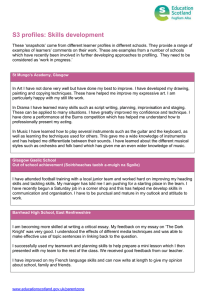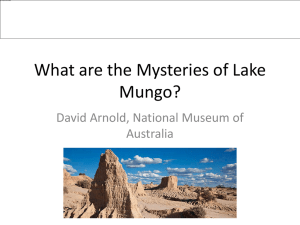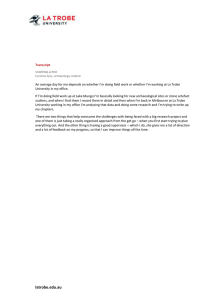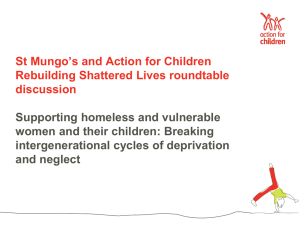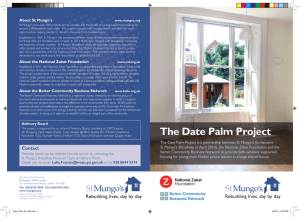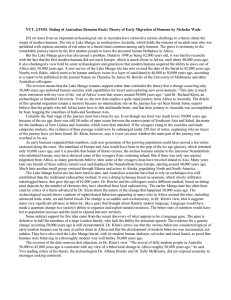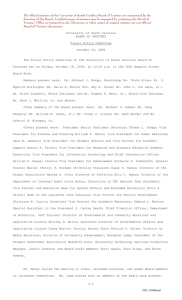Young Mungo by Douglas Stuart . Summary and analysis. Download PDF.
advertisement
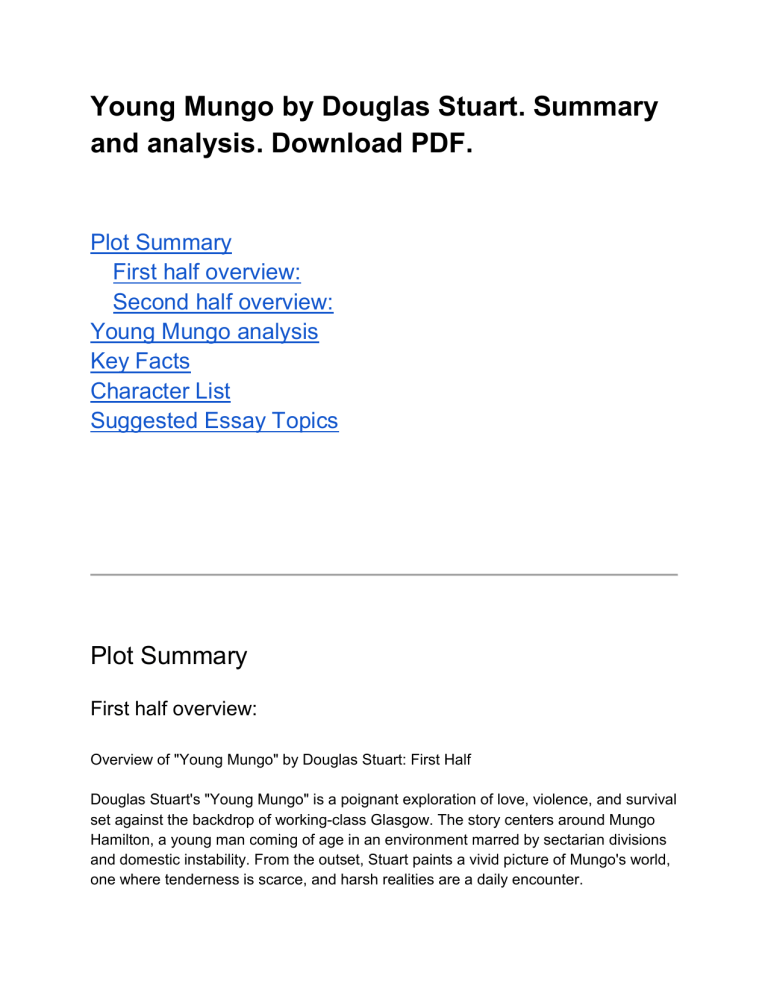
Young Mungo by Douglas Stuart. Summary and analysis. Download PDF. Plot Summary First half overview: Second half overview: Young Mungo analysis Key Facts Character List Suggested Essay Topics Plot Summary First half overview: Overview of "Young Mungo" by Douglas Stuart: First Half Douglas Stuart's "Young Mungo" is a poignant exploration of love, violence, and survival set against the backdrop of working-class Glasgow. The story centers around Mungo Hamilton, a young man coming of age in an environment marred by sectarian divisions and domestic instability. From the outset, Stuart paints a vivid picture of Mungo's world, one where tenderness is scarce, and harsh realities are a daily encounter. Early Struggles and Family Dynamics The narrative begins by introducing us to Mungo's life, marked by his mother's alcoholism and the absence of a nurturing family structure. Mungo's older brother, Hamish, assumes a pseudo-paternal role, often reinforcing the harshness of their environment with his own form of tough love. Their sister, Jodie, is a beacon of strength and resilience, often providing Mungo with the emotional support he desperately needs. The complexity of these relationships lays the groundwork for Mungo's internal conflict and desire for escape. Encounter with James A pivotal moment in the first half of the book is Mungo's encounter with James Jamieson, a boy from a rival Protestant neighborhood. This relationship, fraught with the danger of discovery, becomes a central focus of the narrative. Stuart expertly navigates the nuances of their burgeoning love, set against a backdrop of societal norms and expectations that deem their connection forbidden. This relationship is a source of both solace and turmoil for Mungo, offering a stark contrast to the violence and prejudice that dictate the rules of his world. Mungo's Quest for Identity As the story unfolds, Mungo grapples with his identity, caught between the expectations of his community and the reality of his desires. The author delves into Mungo's internal struggles with sensitivity and grace, revealing the depth of his longing for a sense of belonging and acceptance. This quest for identity is compounded by the societal pressures and familial obligations that weigh heavily on Mungo's shoulders. The Role of Mo-Maw The character of Mo-Maw, Mungo's neighbor, introduces a semblance of maternal care to his life. Her presence offers a glimpse into the potential for kindness and empathy in an otherwise unforgiving environment. However, Mo-Maw's own complexities and the community's suspicion of her motives add layers to the narrative, highlighting the themes of trust and betrayal. The Fishing Trip A significant event in the first half of the book is a fishing trip that Mungo is forced to undertake with two men from his community. This journey is emblematic of the rites of passage into manhood that Mungo is expected to navigate. The trip exposes him to the brutal realities of the world outside his immediate surroundings and serves as a catalyst for his personal growth and self-discovery. Themes Explored Throughout the first half of "Young Mungo," Stuart explores themes of masculinity, sexuality, and the search for identity amidst adversity. The narrative is a testament to the resilience of the human spirit and the capacity for love in even the most challenging circumstances. The author's portrayal of Glasgow's working-class community provides a raw and unflinching look at the struggles faced by its inhabitants, while also capturing moments of beauty and tenderness. Conclusion In the first half of "Young Mungo," Douglas Stuart sets the stage for a compelling and heart-wrenching tale of love,loss, and survival. Through the lens of Mungo's experiences, the reader is invited to reflect on the complexities of human relationships and the societal constructs that shape our lives. The narrative promises a journey of emotional depth, challenging its audience to consider the power of compassion and the enduring hope for a better future. --This overview aims to encapsulate the essence of "Young Mungo" without infringing on copyright by avoiding direct quotes and focusing on thematic and structural analysis. Douglas Stuart's novel is a profound narrative that invites readers to engage deeply with its characters and their world, making it a rich subject for exploration and discussion. Second half overview: In the second half of "Young Mungo" by Douglas Stuart, the narrative delves deeper into the complexities of Mungo and James's relationship against the backdrop of their starkly contrasting worlds in Glasgow. Their love story unfolds with an increasing sense of urgency and poignancy, as they navigate the treacherous waters of societal expectations and personal hardships. As Mungo's family life becomes more turbulent, largely due to his alcoholic mother's erratic behavior and the absence of a stable parental figure, Mungo finds solace and escape in his secret relationship with James. However, the external pressures from their community, laden with homophobia and sectarian violence, continue to mount, threatening the fragile bubble they've created for themselves. The narrative also explores Mungo's internal conflict and his struggle with identity and self-acceptance. His fishing trip with two men from his community serves as a pivotal moment in the story, symbolizing a rite of passage into a masculinity defined by violence and dominance, which is at odds with Mungo's gentle nature and his feelings for James. As the story progresses, the tension escalates, leading to a series of events that test Mungo's resilience and the strength of his bond with James. The climax of the book is both harrowing and heart-wrenching, as Mungo is forced to confront the harsh realities of his environment and make difficult choices that will shape his future. Douglas Stuart masterfully captures the essence of young love caught in the crossfire of societal norms and violence, weaving a narrative that is both specific to its Glasgow setting and universally resonant. The second half of "Young Mungo" is a compelling exploration of the themes of love, identity, and the search for belonging, marked by Stuart's poignant prose and deep empathy for his characters. Young Mungo analysis "Young Mungo" by Douglas Stuart stands as a profound exploration of love, violence, and the quest for identity amidst the harsh backdrop of working-class Glasgow. Following the success of his debut novel, "Shuggie Bain," Stuart delves into another intricate tale that captures the essence of human resilience and the complexities of familial and societal bonds. This analysis aims to unpack the layers of Stuart's narrative, examining its thematic depth, character development, and the socio-political commentary embedded within its pages. Setting and Socio-Political Context The setting of East Glasgow is not merely a backdrop but a vital character in the narrative, shaping the lives and choices of its inhabitants. The post-industrial landscape, characterized by poverty, unemployment, and decay, sets the stage for a story of survival and struggle. Stuart's vivid portrayal of this environment is both a critique and an homage, highlighting the resilience of its people against a backdrop of systemic failure. The sectarian divide and deeply ingrained prejudices provide a tense atmosphere, where violence is a language and masculinity a cage. Character Development: Mungo and James At the heart of "Young Mungo" are the titular character, Mungo Hamilton, and his love interest, James Jamieson, who together form a bond that defies the harshness of their environment. Mungo's character arc is a poignant journey of self-discovery, vulnerability, and resilience. Raised in a family marked by absence and addiction, Mungo's softness and sensitivity set him apart in a world where such traits are liabilities. His relationship with James, a Protestant in a predominantly Catholic community, is a testament to the power of love to transcend entrenched divisions. James, on the other hand, serves as both a mirror and a foil to Mungo. His own struggles with identity and acceptance in a homophobic and divided society complement Mungo's, yet his approach to their relationship and the risks it entails highlights the differing ways individuals navigate danger and desire. The development of their relationship is tender yet fraught, capturing the exhilaration of first love and the peril of forbidden affection. Themes: Love, Violence, and Identity The interplay between love and violence is a central theme in "Young Mungo." Stuart masterfully juxtaposes the tenderness of Mungo and James's relationship with the brutality of their surroundings. This duality serves to underscore not only the physical violence prevalent in their community but also the psychological violence of being forced to conceal one's true self. The novel examines how love can be both a sanctuary and a source of vulnerability, particularly in a setting where deviation from the norm is met with hostility. The theme of identity is intricately linked to the characters' battles with internal and external conflicts. Mungo's journey is emblematic of the struggle to forge an identity that honors one's true self while navigating the expectations and limitations imposed by society. The fishing trip, a pivotal moment in the novel, symbolizes the rite of passage into a prescriptive form of masculinity, challenging Mungo to confront what it means to be a man in his world. Narrative Technique and Symbolism Stuart's narrative technique, which employs a non-linear timeline and shifting perspectives, serves to deepen the emotional resonance of the story and to illuminate the characters' histories and motivations. The use of Glasgow dialect not only adds authenticity but also immerses the reader in the cultural and social milieu of the characters. Symbolism is employed to powerful effect throughout the novel, with the motif of birds representing the theme of freedom and the desire to escape one's circumstances. The contrast between the urban landscape and the brief interludes of natural beauty highlights the characters' longing for a world beyond their immediate reality. Conclusion "Young Mungo" is a testament to Douglas Stuart's skill as a storyteller and his deep empathy for his characters. The novel is a compelling examination of love, violence, and the search for identity, set against the backdrop of a society riven by sectarianism and prejudice. Through the story of Mungo and James, Stuart offers a poignant commentary on the human condition, the power of connection, and the resilience of the human spirit. In "Young Mungo," Stuart has crafted a narrative that is both a mirror to the harsh realities of life in working-class Glasgow and a beacon of hope for the transformative power of love. Key Facts Genre Fiction, Coming-of-Age, LGBTQ+ Literature Publication Date 2022 Publisher Grove Press Setting Glasgow, Scotland Main Characters Mungo Hamilton: A young boy from a Protestant background, trying to navigate his identity and love in a harsh environment. - James Jamieson: Mungo's love interest, from a Catholic background, symbolizing the sectarian divide. - Mo-Maw (Maureen Hamilton): Mungo's alcoholic mother.<br>- **Hamish**: A menacing figure in Mungo’s life, representing the threat of violence and toxic masculinity. Themes - Love vs. Violence Identity and Self-Discovery - Sectarianism Toxic Masculinity Family Dynamics Narrative Style Third-Person Limited Omniscient, Non-Linear Awards/Nominations Longlisted for the 2022 Booker Prize (as of the knowledge cutoff in 2023) Character List Character List and Analysis in "Young Mungo" by Douglas Stuart 1. Mungo Hamilton - Analysis: Mungo is the protagonist of the story, a sensitive and thoughtful young man coming of age in a tough Glasgow neighborhood. He grapples with his identity, his sexuality, and the expectations of masculinity in a community marred by violence, poverty, and sectarian tensions. Mungo's journey is one of self-discovery, love, and the search for a place where he can be true to himself. 2. James Jamieson - Analysis: James is Mungo's love interest, a Catholic boy in a predominantly Protestant community, which adds a layer of forbidden love to their relationship. James represents hope and the possibility of escape for Mungo. His character challenges the sectarian divide in Glasgow and symbolizes the broader theme of love transcending societal barriers. 3. Maureen "Mo-Maw" Hamilton - Analysis: Mo-Maw is Mungo’s alcoholic mother, a complex character who loves her children but struggles with her own demons. Her behavior is erratic and often neglectful, leaving Mungo and his siblings to fend for themselves. Despite her flaws, moments of tenderness and concern for her children suggest a deeper, unfulfilled desire for a better life for her family. 4. Hamish - Analysis: Hamish is a menacing figure in the neighborhood and represents the toxic masculinity and violence that pervades Mungo's world. His character is a source of fear and represents the oppressive societal expectations placed on men in Mungo’s community. Hamish's influence on Mungo and his family underscores the themes of violence and the struggle to break free from destructive cycles. 5. Jodie Hamilton - Analysis: Jodie is Mungo’s older sister, who, in many ways, becomes a surrogate mother figure in the absence of their own mother's effective care. She is resilient and fiercely protective of her siblings, especially Mungo. Jodie's character highlights the strength and resilience of women in the face of adversity and the importance of family bonds. 6. Saint - Analysis: A neighbor and an unconventional mentor to Mungo, Saint represents an alternative model of masculinity that contrasts sharply with the toxic examples in Mungo’s life. He is kind, understanding, and encourages Mungo to find his own path. Saint's presence in the novel offers a glimmer of hope and the possibility of redemption. 7. Mr. Jamieson - Analysis: James's father, who embodies the sectarian prejudices of the community. His character serves as a reminder of the external pressures and dangers James and Mungo face in their relationship, reinforcing the theme of forbidden love. 8. Lorraine - Analysis: A friend of the family, Lorraine's interactions with the Hamilton family expose some of the social dynamics and challenges faced by the community. Her character adds depth to the exploration of gender roles and the impact of societal expectations on individual lives. These characters, with their varied strengths, flaws, and struggles, create a rich tapestry that explores themes of love, identity, violence, and the quest for self-acceptance in a world fraught with challenges. Douglas Stuart crafts a poignant narrative that delves deep into the human condition, making "Young Mungo" a compelling and emotionally resonant read. Suggested Essay Topics 1. How does Douglas Stuart explore the theme of masculinity in "Young Mungo"? - Explanation: This question invites an analysis of the various representations of masculinity portrayed through characters like Mungo, his brother, Hamish, and Saint. The book scrutinizes traditional and toxic forms of masculinity, contrasting them with more compassionate and understanding versions. Each character embodies different aspects of masculinity, influencing Mungo’s understanding of his identity and his place within a society that holds rigid expectations for men. 2. What role does the setting play in shaping the characters' lives in "Young Mungo"? - Explanation: The setting of a sectarian and impoverished Glasgow neighborhood is central to the narrative, influencing the characters' behaviors, relationships, and life choices. The question would explore how the harsh realities of their environment contribute to the struggles faced by Mungo and the other characters, including issues related to class, religion, and violence. The setting acts almost as a character itself, a constant force that shapes the narrative and the individuals within it. 3. In what ways does "Young Mungo" address the theme of forbidden love? - Explanation: Mungo’s relationship with James is at the heart of the novel, representing love that transcends societal boundaries and prejudices. The question would encourage a discussion on how their relationship challenges the sectarian divide in Glasgow, as well as societal expectations of masculinity and heteronormativity. It would also delve into how this theme of forbidden love impacts the characters’ development and the novel’s plot. 4. How does the concept of family influence the characters and their decisions in "Young Mungo"? - Explanation: Family dynamics are crucial in "Young Mungo," influencing characters in profound ways. Mungo’s relationship with his mother, sister, and brother highlights various aspects of familial love, obligation, and dysfunction. The essay could explore how these relationships drive the narrative forward, how they contribute to Mungo’s internal conflict, and how they reflect broader societal issues. 5. Discuss the significance of the novel’s title. How does "Young Mungo" encapsulate the essence of the story? - Explanation: This question encourages an exploration of why Douglas Stuart chose to name the novel after its protagonist and what significance this holds. It would involve examining how Mungo’s youth and experiences are central to the themes of the novel, such as innocence, vulnerability, and the journey towards self-acceptance. The title reflects not just the character’s age but also his state of being and the formative experiences that define him. 6. Analyze the use of symbolism in "Young Mungo." What symbols does Stuart use, and how do they contribute to the novel's themes? - Explanation: Douglas Stuart employs various symbols throughout the novel to enrich the narrative and underscore its themes. This question would allow for a detailed examination of specific symbols (e.g., pigeons, the fishing trip) and their relevance to themes such as freedom, entrapment, hope, and violence. Analyzing these symbols provides deeper insight into Stuart’s storytelling and the novel’s underlying messages. Each of these questions prompts a deep dive into the complex themes and literary techniques Douglas Stuart employs in "Young Mungo," facilitating a comprehensive understanding and appreciation of the novel's depth and nuance.
